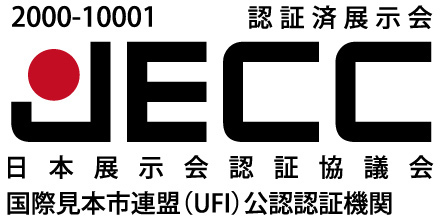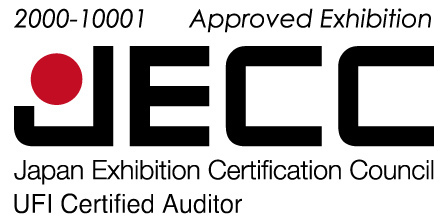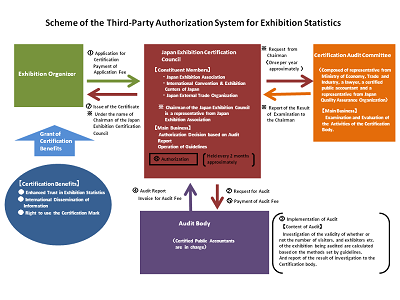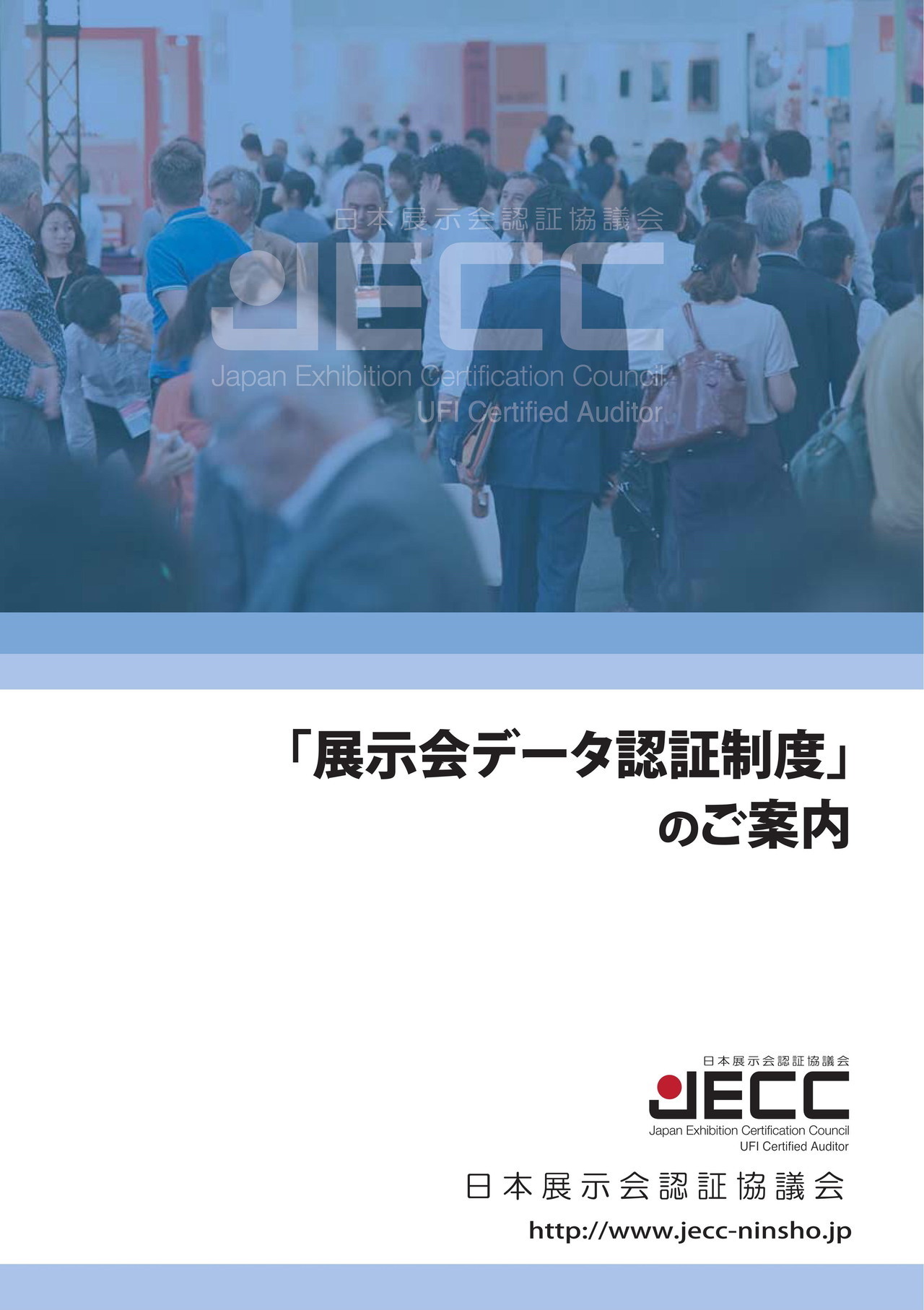Outline of the Authorization System for Exhibition Statistics
Outline of the Authorization System for Exhibition Statistics
1. Background
The exhibition industry makes a major contribution to the development of other industries by facilitating the exchanges of people, goods and information. At the same time it produces spillover effects on the local and regional economies by enhancing their information transmission capacity for local resources and buying power, and by leading to the creation of new businesses.
Many of Japan’s industries have entered a mature phase and are faced with the situation where further domestic demand growth is hard to expect. The nation needs to actively attract external demand from overseas countries, particularly Asian nations which are growing rapidly, and to stimulate corporate transactions both in and outside Japan.
In the past various statistics within Japan’s exhibition industry have been unclear, the standards for such statistics have been inconsistent, and comprehensive data pertaining to the actual exhibition results were inadequate. Recognizing this problem, the Japanese Ministry of Economy, Trade and Industry (METI), has taken steps aimed at improving statistical data and enhancing the exhibition industry. These steps included carrying out a survey project in 2010 to establish standards for exhibitions, undertaking a project in 2011 to framework the Authorization System for Exhibitions, and launching the authorization system in 2012.
2. Purposes of the Authorization System for Exhibition Statistics
[Extract from METI 2010 Report on the Survey Project about the Environmental Improvement of Japan’s Service Industries]
To consolidate exhibition statistics with high reliability and transparency by introducing the Authorization System for Exhibition Statistics.
To unify the definitions related to the exhibition industry and the indicators for the industry’s statistical data and to establish the standards for the exhibition statistics.
3. Importance and Significance of the Authorization System for Exhibition Statistics
As a general rule, the more that world markets expand and become globalized, the stronger the demand for international exhibitions becomes. Keeping this fact in mind, in order for Japan’s exhibition industry to cast off its reclusiveness and become more international in nature, and to obtain the assurance that the exhibitions held in Japan are held with transparency, reliability, and quality, it is necessary to consolidate the statistics about the numbers of visitors and exhibitors, etc., comparable with the world statistics. Since only consolidating these statistics enable us to obtain exhibitors and visitors alike with higher quality, we believe it is very meaningful to move ahead on the Authorization System for Exhibition Statistics. Exhibition organizers are expected to make effective use of this authorization system.
4. Effects of the Authorization System for Exhibition Statistics
Introducing the Authorization System for Exhibition Statistics, we believe, will facilitate the preparation of the exhibition-related statistics and will enable us to evaluate the economic spillover effects. In addition, it will be possible to analyze the current situation, trends, and the international advantages of Japan’s exhibition industry, and we will be able to formulate medium- and long-term strategies based upon such analyses. Moreover, it can be expected that the Authorization System for Exhibition Statistics will strengthen the reliability and transparency of Japan’s exhibition industry, stimulate the participations or visits from both inside and outside of Japan, and drive the internationalization and vitalization of Japan’s exhibition industry and, eventually, of the Japanese industries as a whole.
5. Definition of the Terms Used in the Authorization System for Exhibition Statistics
[Extract from METI document prepared for the 2011 Committee for Vitalization of Japan’s Exhibition Industry]
The Authorization System for Exhibition Statistics is the system to authorize those exhibitions to which the exhibition statistical data, such as the number of visitors or visits, the number of exhibitors, and the exhibition areas, are applied based upon the definitions and indicators determined in the guideline of the Authorization System for Exhibition Statistics.
* Those exhibition organizers who want their exhibitions to be authorized must submit their exhibition statistical data based on the definitions and indicators determined in the guideline of the Authorization System for Exhibition Statistics.
6. Exhibitions Covered by the Authorization System for Exhibition Statistics
The Authorization System for Exhibition Statistics is applied only to those exhibitions that have been put forward for authorization by the organizers. In addition, the statistical data is collected only from the exhibitions which use counting methods that comply with the international standards.
[Categories of exhibitions]
| Category | Authorization standards | ||
| Counting methods of visitors | Visitors/Exhibitors
| ||
| Exhibitions | I. International exhibitions that comply with the ISO standards and other standards applied to international exhibitions |
| More than 5% of the total number of visitors or more than 10% of the total number of exhibitors must be from overseas.
|
| II. General exhibitions other than international exhibitions that comply with the standards applied to international exhibitions
|
| (No specific regulations or limitations)
| |
| III. Exhibitions
|
| (No specific regulations or limitations)
| |
| Events similar to exhibitions but not categorized as exhibitions | Flea markets, sidewalk sales, etc.
| ||
7. Definitions and Indicators Determined in the Guideline of the Authorization System for Exhibition Statistics
[Definitions and terms determined in the METI 2010 Survey Project about the Environmental Improvement of Japan’s Service Industries]
(a) Definitions of “exhibitors” and “exhibitions”
- “Exhibitors” include “main exhibitors” and “co-exhibitors.”
- “Main exhibitors” mean those exhibitors who contract directly with the exhibition organizer.
- “Co-exhibitors” mean those exhibitors who exhibit their products/services in another exhibitor’s exhibition booth.
- Co-exhibitors must always elucidate its name and address.
- “Group exhibitions” mean those exhibitions where a main exhibitor rents the exhibition space and a number of co-exhibitors share the space.
(b) Nationality of exhibitors
- The nationality of an exhibitor is determined according to the address declared by the exhibitor to the exhibition organizer.
- “Overseas exhibitors” mean those exhibitors whose addresses declared to the exhibition organizer are overseas. An overseas company’s local subsidiary in Japan who contracts with an exhibition organizer should be categorized as a domestic exhibitor.
(c) Definition of “visitors”
- “Visitors” mean those people who visit exhibitions with the purposes of collecting information, purchasing products, and contracting with exhibitors; however, exhibition organizers, exhibitors, newspersons, and service providers related to exhibitions are not counted as “visitors.” Speakers are counted as “visitors” only when they visit exhibitions with the above-mentioned purpose.
[Those who should be excluded from “visitors”]
- Staff hired by exhibition organizers
- Staff hired by exhibitors
- Staff working at the exhibition facilities
- Service providers related to exhibitions (decorators, clean staff, security agents, etc.)
- Speakers invited by exhibition organizers or exhibitors
- News persons
(d) Counting method for visitors and visits
The entry of one person during the period of the exhibition, regardless of the number of his/her visits, is counted as the “number of visitors.” (The number of entries to the exhibition by that person during the period of the exhibition, can be counted as the “number of visits.”)
(e) Nationality of visitors
- The nationality of a visitor is determined according to the address declared by the visitor to the exhibition organizer.
- “Overseas visitors” mean those visitors whose addresses declared to the exhibition organizer are overseas. An overseas company’s local staff in Japan who visits exhibitions should be categorized as a domestic visitor.
(f) Size of exhibition space
“Size of exhibition space” means the total of the space the exhibitor rents from the exhibition organizer, either with or without charge, and the space used by the exhibition organizer or exhibition secretariat for exhibiting directly related to the subject of the exhibition.
Note: We follow the definitions of the terms related to the exhibition statistics determined in the METI 2010 Survey Project about the Environmental Improvement of Japan’s Service Industries (the Survey Project about Establishing the Standards for Vitalization of the Japanese Exhibition Industry and Formulating the Visions). However, they can be revised, if necessary, through the consultations by the related persons.
8. Fee for the Authorization System for Exhibition Statistics
The fee for the Authorization System for Exhibition Statistics is 300,000 Japanese yen per one exhibition.
9. Authorization Mark Given to the Authorized Exhibitions
The exhibitions authorized through the Authorization System for Exhibition Statistics are given the Authorization Mark, whose image is shown below.
[Specimen of the Authorization Mark]
Japanese

English

10. Scheme of the Authorization System for Exhibition Statistics
[Concept of the scheme]
11. Role of Each Party Involved in the Authorization System for Exhibition Statistics
(1) Exhibition organizer
Exhibition organizers can apply for the authorization for exhibition statistics.
(2) Authorization body (Japan Exhibition Certification Council)
The authorization body (Japan Exhibition Certification Council) serves as the “reception desk” to accept the exhibition organizers’ applications and as the overall secretariat function for the Authorization System for Exhibition Statistics including requesting the investigative body to make a necessary investigation. The authorization body also conducts a review for authorization for exhibition statistics based on the reports submitted by the investigative body.
(3) Investigative body
The investigative body makes an investigation, based on the authorization body’s request, for the exhibitions for which the authorization applications were submitted about whether the various statistical data submitted by the investigative body are complied with the definitions and rules determined in the guideline.
(4) Certification Audit Committee
Certification Audit Committee conducts, based on the request by the authorization body’s chairperson, a review about once a year and check whether the Authorization System for Exhibition Statistics is managed fairly and properly.





